Essential Insights into Kite Surfing Lessons
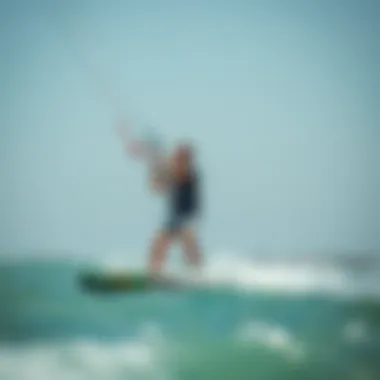
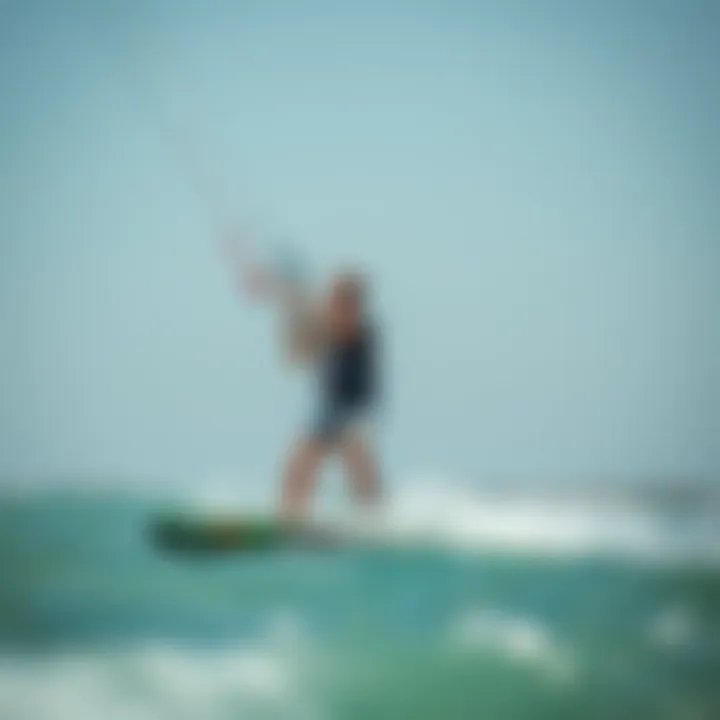
Intro
Kite surfing is more than just a sport; it’s a dance with the elements, marrying the freedom of the wind with the allure of the water. As exhilarating as it can be, diving into kite surfing requires more than just a spirit of adventure. It calls for the right knowledge, skills, and equipment to truly enjoy the experience. For anyone looking to step onto the ever-changing canvas of the sea with a kite in hand, understanding the ins and outs of kite surfing lessons is vital.
Whether you're a newcomer fresh off the beach or an experienced boarder looking to refine your techniques, proper guidance can make a world of difference. The enchantment of gliding across waves while being propelled by a colorful kite can be a thrilling sensation, but without adequate knowledge, the journey can be fraught with challenges.
In this guide, we'll unfold various crucial aspects of kite surfing lessons. From gear selection to skill development, we aim to provide insights that not only streamline your learning but also enrich your overall experience in kiteboarding. Let's delve deeper into the key points that revolve around gear, techniques, instructors, and safety, laying a solid foundation for all aspiring kite surfers.
Gear Selection
Before you hit the water, it's essential to have the right equipment. The selection of gear can dictate not just your performance, but also your safety and enjoyment while kite surfing. Below, we’ll explore the two main components: kites and boards.
Types of Kites
Selecting the right kite is akin to choosing the perfect sailing vessel—it largely depends on your ability, preferred conditions, and even your style. Generally, kites fall into three main types:
- C-Kites: Known for their pure performance, they're great for tricks and jumps. However, they can be a handful for beginners.
- Bow Kites: These offer excellent power and stability. Their design allows for easier handling, making them favorable for newcomers.
- Delta Kites: Combining features of both, these kites are versatile and good in various wind conditions.
Choosing the right kite involves understanding these characteristics, as well as assessing your local conditions—from wind patterns to water currents. Consulting with experienced riders or instructors can provide invaluable guidance in making the right choice.
Choosing the Right Board
Your board plays an equally significant role in shaping your kite surfing experience. The variety of boards available can seem overwhelming, but breaking it down into categories can help:
- Twin-Tip Boards: These are the most common type, offering versatility and ease of use for all skill levels. They allow for riding in both directions, making them the most beginner-friendly option.
- Directional Boards: Ideal for those looking to embrace more traditional surfing, these boards are great for wave riding but require a bit more skill and practice.
- Foil Boards: These are the latest trend in kiteboarding, allowing riders to glide above the water. It often requires more advanced techniques but provides a unique experience.
When deciding on a board, focus on your skill level, the kind of riding you want to do, and the local conditions. Every surfer has unique preferences, and trial and error can often lead to the perfect fit.
Skill Development
Once you've sorted the gear, it’s time to refine your skills. Mastering the art of kite surfing involves continuous learning and practice.
Essential Techniques
Even before stepping on the board, some key techniques will set the stage for success:
- Kite Control: This is foundational. Understanding how to steer the kite is critical. Beginners should focus on flying it properly before attempting to get on the board.
- Water Starts: Mastering this technique can dramatically improve your confidence and ability to get on the board quickly.
- Riding Techniques: As you progress, practicing various riding styles (like jumping or carving) showcases the versatility of kite surfing.
Progression Tips
To make tangible progress in kite surfing:
- Consistent Practice: Like any sport, consistency is key. Regular sessions can fast-track your learning.
- Take Lessons: Enroll in lessons with qualified instructors. Their experience can point out mistakes you may not notice between sessions.
- Observe Others: Watching other riders can introduce new techniques and styles. Pay attention to their movements and how they handle the kite and board.
Remember: Mastering kite surfing isn't an overnight endeavor; it requires patience and perseverance along with practice.
Intro to Kite Surfing
Kite surfing combines the thrill of surfing with the power of the wind, creating an exhilarating water sport that has captivated many around the globe. The importance of understanding kite surfing cannot be overstated. This section lays the groundwork for the entire guide, outlining what makes kite surfing more than just a pastime. It's a challenging yet rewarding endeavor that necessitates proper training, knowledge of equipment, and awareness of safety measures.
Notably, kite surfing fosters a sense of connection with nature, blending the elements of air and water in a spectacular dance. Many enthusiasts feel the call of the ocean, with its waves and winds, while others are drawn to the technical aspects of controlling the kite itself. Embracing this sport opens new horizons not only in skill development but also in building a vibrant community among participants.
History and Evolution of Kite Surfing
Kite surfing's history is rich and varied, tracing back to the early forms of kite-flying in China, where kites were first used in military applications. However, the sport as we know it today began to take shape in the late 20th century when pioneers like Gordon and Bruno Léglise introduced the first kites designed specifically for water sports in the 1980s. At this point, aspiring kite surfers began experimenting with different designs, materials, and techniques.
As equipment evolved, so did the sport itself. The introduction of safety features like depowerable kites and advanced control systems made it more accessible and safer for novices. By the early 2000s, kite surfing gained mainstream popularity, with schools popping up in beach towns worldwide. The sport has since continued to innovate, giving rise to various styles, including freestyle and wave riding. Kite surfing has transitioned from novelty to a recognized sport, complete with competitions and a devoted following across the globe.
The Appeal of Kite Surfing
The allure of kite surfing lies not only in the adrenaline rush but also in its unique lifestyle. Many practitioners find beauty in the sport's ability to combine athleticism with artistry.
Here are a few reasons why kite surfing captures the hearts of many:
- Sense of Freedom: Riders glide over the water, propelled by wind, experiencing pure liberation.
- Connection with Nature: There's something therapeutic about harnessing the elements, feeling the breeze and waves in perfect harmony.
- Community Spirit: Kite surfing fosters a welcoming culture, with many enthusiasts eager to share their experiences and tips with newcomers.
- Challenge and Mastery: As with any sport, there's always room for improvement in kite surfing. The journey from a beginner to an advanced rider is filled with valuable experiences and skills gained along the way.
"Kite surfing is more than just a sport; it’s a lifestyle. You learn to respect the elements and also to find joy in unpredictability."
In summary, this introduction into kite surfing elucidates not only the sport’s deep-rooted history but also its magnetic appeal. For anyone considering taking lessons or furthering their skills, understanding these foundational aspects is crucial for getting the most out of the kite surfing experience.
Understanding the Basics
Kite surfing is more than just a thrilling water sport; it’s a harmonious blend of skill, nature, and equipment. To embark on this adventure, grasping the basics is a non-negotiable step. Whether you’re a curious newcomer or someone looking to refine your existing skills, understanding foundational concepts opens doors to more complex maneuvers and enhances your overall experience.
Grabbing the right knowledge sets the stage for what is to come. It's not just about riding the waves but mastering the tools and safety protocols that ensure an enjoyable journey. This section lays down essential terminology and provides a thorough overview of the equipment needed, creating a solid reference point as you progress.
Essential Terminology
Before hitting the water, getting familiar with the lingo that kite surfers use is imperatively useful. Here are some of the most vital terms:
- Kite: This is the large inflatable or foil that captures the wind, pulling the surfer across the water.
- Bar: A control bar is used to steer the kite. It connects to the lines and allows for adjustments to the angle and direction.
- Lines: These are the strings that connect the kite to the bar, coming in various lengths depending on the kite size.
- Depower: This term refers to reducing the kite's power by trimming the lines, usually done in strong winds.
- Downwind: This indicates the direction the wind is blowing, often used when talking about maneuvering.
Familiarity with these terms enables smoother communication and understanding among fellow kite surfers, instructors, and potentially in online forums like reddit.com. These bits of knowledge are not minor; they form an indispensable lexicon that enriches the experience.
Equipment Overview
Having a firm grasp on kite surfing equipment is equally crucial. Here’s an overview of the essential components that come into play:
Kite Types
When it comes to kite types, it's a matter of choosing the right tool for the job. Kites generally fall into two major categories: inflatable kites and foil kites. Inflatable kites are favored for their durability and safety. Their ability to hold air provides excellent stability and maneuverability, making them a common choice for beginners. On the other hand, foil kites are lightweight and often used for more advanced moves. They offer great performance in varied wind conditions but might require a bit more skill to handle proficiently.
"Selecting the right kite type can significantly impact your learning curve — don't rush your choice."
Boards
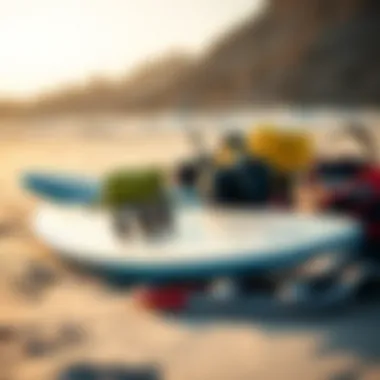
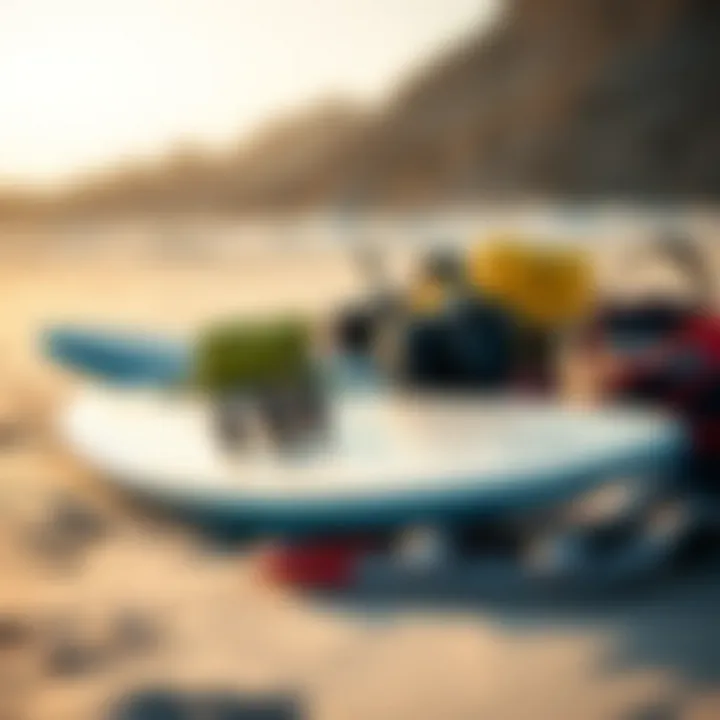
The board you stand on is the second half of the equation. Kite surfing boards come in different shapes, sizes, and materials, heavily influencing the riding experience. Directional boards are designed specifically for riding downwind, while twin-tip boards allow for easier navigation in both directions. The choice of board can affect how well you can perform jumps and turns. Most beginners tend to start with twin-tip boards for their versatility, which makes learning simpler. However, as skill improves, experimenting with directional boards can offer new challenges and thrills.
Harnesses
Harnesses tether the rider to the kite, allowing for better energy transfer while minimizing fatigue. They come in two main types: seat harnesses and waist harnesses. Seat harnesses provide more support for the lower back, making them a favorable option for those who may want extra comfort during longer sessions. Waist harnesses, on the other hand, allow for a greater range of motion, beneficial for advanced maneuvers. Choosing the right harness can directly influence the comfort and effectiveness of your kite surfing.
Safety Gear
Safety gear is non-negotiable in kite surfing. A life vest and a helmet can play vital roles in protecting you from unforeseen accidents. It's also wise to consider impact vests designed to minimize injuries when falling. Additionally, a safety leash ensures that if you separate from your kite or board, you have a way to retrieve them quickly, keeping you safe and stress-free. Investing in good quality safety gear can save you from unfortunate mishaps.
In summary, having a solid understanding of essential terminology and the main types of equipment sets the stage for your kite surfing lessons. It builds a solid foundation necessary for navigating the complexities of the sport, making it easier to integrate skills as you progress. As the saying goes, "knowledge is power," and in kite surfing, it plays a crucial role in ensuring safety and enjoyment.
Choosing a Kite Surfing School
Selecting the right kite surfing school can make or break your adventure in this exhilarating sport. It’s akin to finding the right pair of shoes before a long trek; if they don’t fit well, you won’t enjoy the journey. With the multitude of options available, it’s crucial to navigate through the noise and focus on what truly matters. A quality school can provide you with the foundational skills and confidence necessary to tackle the challenges that kite surfing brings.
Accreditation and Standards
Accreditation is essential in ensuring that the school meets specific safety and training standards. A school that has received recognition from reputable kite surfing organizations, like the International Kiteboarding Organization (IKO) or the British Kite Sports Association (BKSA), often signals a commitment to high-quality instruction.
- Check Certificates: Any school worth its salt will display certifications clearly. It's not just a feather in their cap; it acts as a guarantee that they adhere to rigorous teaching methods and safety regulations.
- Follow Established Guidelines: Accredited schools typically follow standardized curricula that cumulatively build your skills over time. This structured approach can be comforting, especially for newcomers who might feel overwhelmed by various techniques and equipment.
- Consistency in Training: With accreditation comes accountability. Schools under reputable associations often have ongoing assessments ensuring that instructors remain sharp and updated on best practices. This constant refinement translates to better learning experiences for you.
In short, don’t skimp on due diligence. Research and ensure that the kite surfing school you choose has the credentials to back its claims.
Instructor Qualifications
The instructors at a kite surfing school are your guiding lights; they are the ones who will navigate you through the seas of knowledge about the sport. Their qualifications should not be taken lightly.
- Experience Matters: Look for instructors who are not only certified but also possess years of hands-on experience. The charm of an instructor isn’t just in their knowledge; it’s also in their ability to impart that knowledge effectively. Veterans can share tips that aren't found in textbooks—little nuggets of wisdom that come from countless hours spent on the water.
- Personalized Teaching Style: Every learner is different. An excellent instructor will adapt their teaching style to fit your needs. Some students thrive with structured lessons, while others may prefer a more relaxed approach. Ensure that the school values individual learning preferences and offers tailored instruction.
- Continual Learning: The best instructors will demonstrate a commitment to their own growth, attending workshops and staying abreast of new techniques. This ongoing journey inspires confidence in their ability to provide you with the latest and most effective training methods.
Facilities and Safety Measures
The environment in which you learn is as important as the instruction itself. A kite surfing school’s facilities and safety measures play a significant role in ensuring that you have a safe and enjoyable learning experience.
- Location and Accessibility: The school’s location should have ample space for lessons, with suitable wind conditions and water conditions for your skill level. Areas with shallow waters can provide a safer learning environment for beginners.
- Safety Gear Availability: A reputable school should provide all necessary safety equipment, including helmets, life jackets, and safety leashes. You should never feel like you’re cutting corners on safety—if a school minimizes the importance of protective gear, it’s a red flag.
- Emergency Protocols: Understand what safety protocols are in place. Good schools will have clear plans for handling emergencies, such as dealing with equipment failure or sudden weather changes. Make sure they conduct regular safety drills to reinforce these protocols.
To summarize, when choosing a kite surfing school, focus on accreditation, the qualifications of instructors, and the state of their facilities. In doing so, you lay down a solid foundation upon which to build your kite surfing skills and experience.
Types of Kite Surfing Lessons
Kite surfing can be an exhilarating experience, but the journey often starts in the lessons. Choosing the right type of lesson is crucial to ensuring that skills are learned effectively and safely. Each format of lessons—private, group, or online/hybrid—has its unique features, benefits, and considerations, which cater to different learning styles and preferences.
Private Lessons
Private kite surfing lessons stand out for their customized approach. With one-on-one instruction, learners get the full attention of their instructor, which can significantly expedite the learning process. This format suits many individuals, especially those who prefer a more personal learning experience. Benefits of private lessons include:
- Tailored Instruction: The instructor can craft lessons that align with the learner’s pace, skill level, and specific goals.
- Immediate Feedback: Direct observation allows for instant correction, ensuring that errors are addressed on the spot.
- Flexible Scheduling: These lessons usually offer more flexibility in terms of timing, allowing participants to choose when they want to hit the waves.
However, private lessons may also be more expensive, and for some, the lack of peers might limit the social aspect of the sport. Ultimately, if your focus is on honing skills quickly and effectively, private lessons may be the way to go.
Group Lessons
Group lessons present a different vibe from private sessions. They often foster a sense of camaraderie and community, which can enhance the learning experience. Sharing the lesson with others provides a platform for peer encouragement, where learners can motivate and learn from each other. Highlights of group lessons include:
- Cost-Effectiveness: Typically, group lessons are more affordable than private options, making them accessible to a broader audience.
- Networking: Meeting fellow enthusiasts can lead to friendships and potential riding partners outside of lessons.
- Learning from Others: Watching peers tackle similar challenges can help in understanding techniques more deeply.
- Fun Atmosphere: The group dynamics can make learning less intimidating and more enjoyable.
Of course, it’s important to note that group settings may yield less personalized instruction. Some may find it challenging to get enough attention from instructors in larger groups, meaning that progress might take a little longer as compared to private lessons.
Online and Hybrid Courses
In recent years, online and hybrid kite surfing courses have soared in popularity. These lessons enable aspiring kite surfers to learn foundational principles from the comfort of home, often through video tutorials and online discussions. Hybrid courses combine online theory with practical on-water sessions, creating a blended approach to learning. Key features of online and hybrid courses include:
- Flexible Learning: Participants can learn at their own pace and revisit materials as often as needed.
- Cost-Effective: Often cheaper than face-to-face lessons, they provide an economical option for those on a budget.
- Accessibility: Perfect for those who cannot access a local kite surfing school or want to get a head start before hitting the water.
Nonetheless, while online courses provide valuable knowledge, they can’t fully replace the experience of hands-on training. Physical skills developed on the water still require a practical setting, making hybrid options particularly appealing for those wanting a mix of theory and real-world practice.
In short, the choice of lesson type should align with your personal goals, schedule, and budget. Evaluate what kind of support you need to thrive as you embark on your kite surfing path. As with many things in life, what works best will vary from person to person. Finding the right fit is key to enjoying this exhilarating sport.
Progressing Through the Lessons
When delving into the sport of kite surfing, understanding how to progress through the lessons is crucial. The journey isn’t just about riding the waves; it’s a blend of developing skills, gaining confidence, and fostering a deep connection with the sport. Having structure in the learning path can make the difference between a novice who feels overwhelmed and one who embraces the thrill with open arms. The learning curve can be steep, but with appropriate guidance, it becomes an empowering experience.
Initial Techniques
The groundwork for a successful kite surfing journey lies in mastering initial techniques. It’s about becoming familiar with the kite and board, the symbiotic relationship between the two, and the fundamental skills every rider needs to learn. Here are two essential components of this starting stage.
Launching and Landing the Kite
Launching and landing the kite serves as the bedrock for kite surfing. This isn’t just a simple act; it’s the gateway to safely operating the equipment. When you learn to launch, you understand the dynamics of wind and control. A key characteristic of this technique is managing the tension in the lines. You need to be aware of your surroundings to avoid misfortunes. The benefits of mastering this include a drastic reduction in mishaps that could hinder your experience. However, getting it wrong can lead to dangerous situations, emphasizing the importance of practicing under supervision.
Pros of Launching and Landing the Kite:
- Teaches responsible kite handling
- Builds confidence and control
- Essential for smooth transitions to advanced techniques
Cons:
- It can be daunting for beginners
- Risk of injury if not done correctly
Basic Board Skills
Basic board skills usher in another layer of competence for aspiring kite surfers. Understanding how to maneuver on the board increases your ability to stay balanced while harnessing the power of the kite. A key aspect is finding your footing—literally. This skill enables you to have control when you catch the wind.
The unique feature of basic board skills is the way it builds an intuitive understanding of the water. Being able to read the surface conditions opens up more opportunities to progress quickly. Practitioners often find this is a beneficial area to focus on as it sets up for more fluid riding and enhances enjoyment. There are, however, challenges, as falls are common while learning.
Advantages of Basic Board Skills:
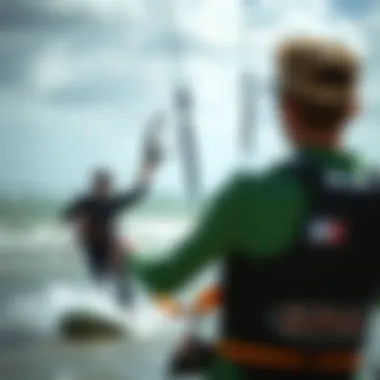
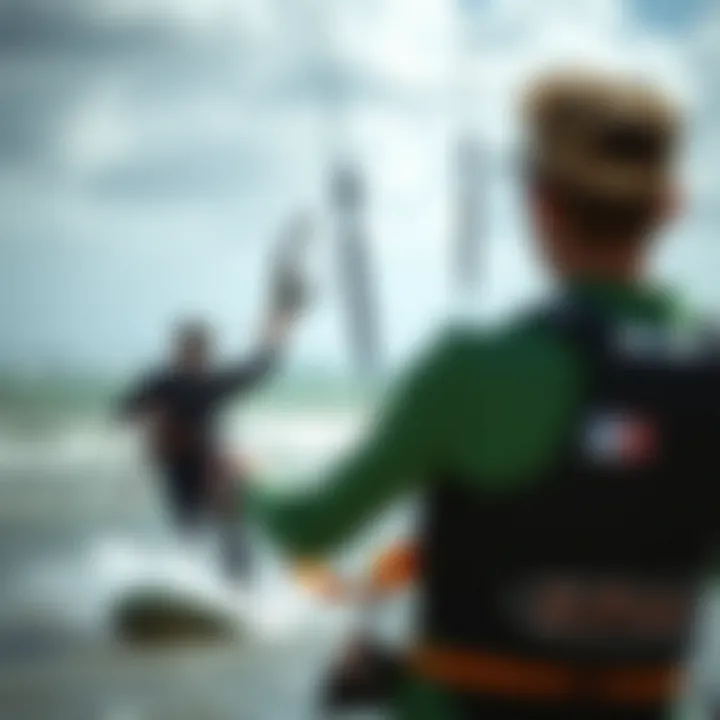
- Enhances stability and comfort
- Provides a foundation for more complex tricks
- Encourages proper posture and technique
Disadvantages:
- Requires repeated practice—patience is key
- Initial falls can discourage newcomers
Intermediate Skills
Once riders feel at home with the basics, it’s time to shift gears and dive into intermediate skills. This phase is thrilling, as it introduces new techniques that allow for greater expression and enjoyment on the water. Here are two essential skills that kite surfers typically develop during this stage.
Riding Techniques
Riding techniques encompass various methods of moving across the water while maintaining control. Gaining a solid grasp of these techniques fuels progression towards more advanced maneuvers. One defining point is the understanding of how to use the kite’s power efficiently, which advocates smooth energy transfer while riding. This stage of learning is typically welcomed by students, as once they get it, they feel a new sense of liberation.
Advantages of Riding Techniques:
- Increases speed and maneuverability
- Encourages rider independence
- Leads to the confidence needed for tricks
Disadvantages:
- Can be physically demanding; stamina is required
- Risk of falling and injury when trying higher speeds
Turning and Stopping
Turning and stopping go hand in hand, forming an integral part of riding that prevents it from becoming chaotic. Mastering these skills allows you to control direction and speed efficiently, which is critical when navigating busy surf spots or at high speeds. This lesson highlights timing and patience, as successful stopping requires perfect synchronization between board and kite movements.
The need for solid turning techniques is vital because it makes versatile riding possible. Riders who understand how to turn and stop can react better to changing conditions and other surfers on the water.
Pros of Turning and Stopping:
- Expands the range of movement and control
- Enhances safety by avoiding collisions
- Allows for smoother transitions to advanced maneuvers
Cons:
- Initial learning periods can lead to falls
- Requires a solid comprehension of kite control
Advanced Maneuvers
The peak of kite surfing experience arrives with the realm of advanced maneuvers. This step is where creativity blooms and riders can showcase their personality through tricks and jumps. It’s not just about skill; it’s also about style and flair. Here’s a look at two key components.
Jumping Techniques
Jumping techniques form an exhilarating part of kite surfing. The thrill of catching air is what captivates many riders. A significant aspect of learning to jump is timing: coordinating the power from the kite with the pressure from the board needs to be second nature. Advanced jumpers have learned how to use the wind and waves to propel themselves skyward, creating awe-inspiring visuals.
Jumping is a prized skill in kiteboarding, as it allows for self-expression. Riders often seek to combine tricks with jumps, giving the activity a competitive edge. Perfecting this technique requires diligence, but leaves riders feeling accomplished.
Advantages of Jumping Techniques:
- Offers opportunities for creativity
- Establishes excitement and achievement
- Engages audiences during competitions and events
Disadvantages:
- Higher risk of falls and injuries
- Requires advanced understanding of kite dynamics
Tricks and Freestyle
Exploring tricks and freestyle techniques is where riders truly show their artistry. This arena highlights individuality and advanced skill levels. Riders can blend multiple elements and techniques that have been honed over time. Unique tricks can lead to recognition in the kiteboarding community.
The significant characteristic of this area is its ever-evolving nature. Trends and styles change, keeping the sport fresh and demanding continual learning. Engaging with this portion of kite surfing is rewarding, yet can be daunting, as creativity must be balanced with technique.
Pros of Tricks and Freestyle:
- Encourages personal expression and exploration
- Offers chances to be involved in competitions
- Expands skill sets and aids in community building
Cons:
- Requires intensive practice and patience
- Risks associated with high-level maneuvers
Attaining mastery in kite surfing involves continuous learning and adapting through various stages. As individuals progress from initial techniques to advanced maneuvers, they build confidence, skill, and deep bonds with the sport. Understanding these elements not only enhances personal growth but also contributes to the kiteboarding community as a whole.
Safety Considerations
When it comes to kite surfing, safety is not just a guideline but a fundamental principle. Both newcomers and veterans in the sport need to comprehend that kite surfing comes with inherent risks. The vast ocean and unpredictable winds can create challenging conditions, so having a solid understanding of safety practices is crucial.
Understanding Weather Conditions
Before hitting the water, it’s essential to assess the weather. Many mistakes stem from inadequate weather evaluations, which can lead to dangerous situations.
Some key factors to consider include:
- Wind Speed and Direction: Knowing the wind speed is vital. A breeze of 8 to 20 knots is typically ideal for beginners, while advanced riders may thrive in stronger winds. Understanding how to face onshore, offshore, and cross-shore winds can significantly affect your riding experience.
- Tides: Changes in tides can dramatically influence water conditions. Rising tides may present new obstacles, while falling tides can create stronger currents, requiring adaptability.
- Local Weather Patterns: Every location has its own quirks. Familiarize yourself with the local conditions or check forecasts from reliable sources such as National Weather Service or Windy to ensure an enjoyable ride.
The key takeaway is that knowledge is power. Understanding weather can prevent many mishaps and lead to better decision-making. As a result, you can enjoy your kite surfing session with fewer worries.
Rescue Techniques
Accidents can happen, even to the most seasoned kite surfers. Hence, knowing rescue techniques is not just wise but necessary. In various situations, it's essential to stay calm and to know how to help yourself and others.
Some common rescue techniques include:
- Self-Rescue: If you find yourself in trouble, such as getting tangled in your lines, using your knowledge of self-rescue is vital. Release your kite by activating the quick release feature of your harness. Then, use the board to paddle back to the shore while keeping an eye on your kite.
- Assisting Others: If someone else is in dire straits, alerting fellow surfers or notifying local rescue services is imperative. If you’re within reach, throw a flotation device, such as a buoy or any floating equipment, to the person in need.
- Communicate: Never underestimate the power of clear communication. Use hand signals or shout instructions if you need help. Being clear can make all the difference in a time-sensitive situation.
“When seconds count, having clear procedures saves lives.”
By knowing the key rescue techniques, you lessen the risks not only for yourself but for the kite surfing community at large. The empowerment gained from understanding these safety measures enhances not just the enjoyment but also the overall experience of the sport.
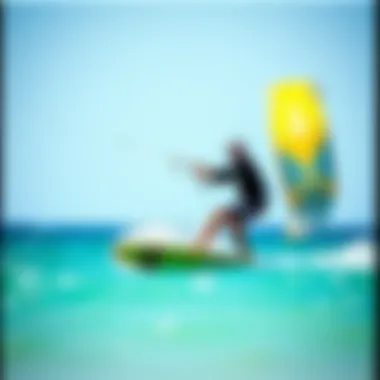
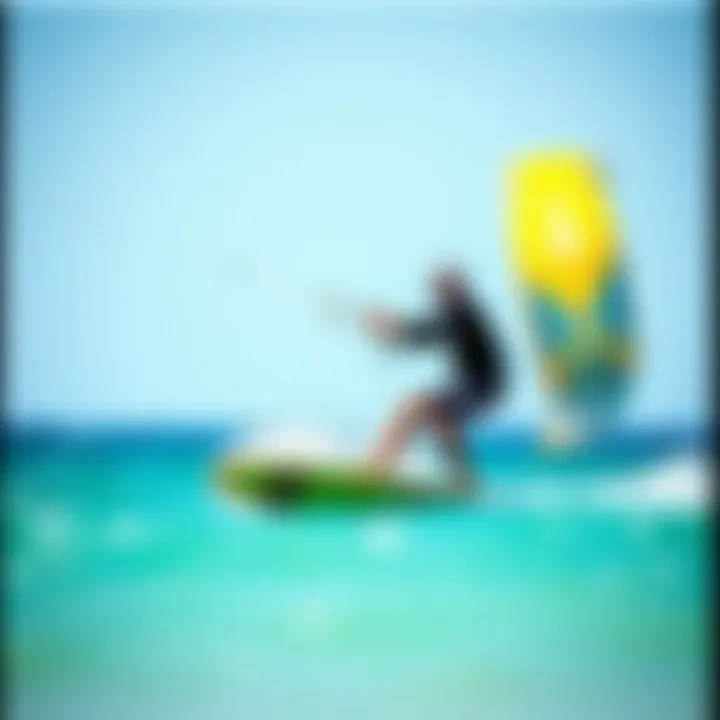
Environmental Impact and Responsibility
Kite surfing is not just a thrilling sport; it is also a practice deeply intertwined with the natural environment. As enthusiasts of the great outdoors, kiteboarders must recognize the ripple effects their activities can have on local ecosystems. Understanding and addressing environmental impact is vital for the sustainability of kite surfing, ensuring that we can enjoy the wind and waves for years to come.
One of the primary concerns is how kite surfing affects coastal areas and water bodies. Kiteboarding, if done thoughtlessly, can lead to beach erosion and disturb marine life. Therefore, responsible kiteboarders must learn eco-friendly practices and abide by local regulations to protect these precious habitats.
Establishing a solid foundation of eco-conscious behavior not only preserves the environment but enhances the community's connection to the sport. This relationship fosters a sustainable future that allows newcomers and seasoned riders to share the thrill of kite surfing responsibly.
"We do not inherit the earth from our ancestors; we borrow it from our children." - Native American Proverb
Eco-Friendly Practices
Implementing eco-friendly practices while kite surfing can significantly reduce the sport's environmental footprint. Here are several actionable strategies:
- Leave No Trace: Ensure that you carry out everything you bring to the beach. This includes any personal items, wrappers, and broken gear parts. Keeping beaches clean protects wildlife and maintains the natural beauty of these areas.
- Choose Eco-Friendly Gear: Many companies now produce environmentally conscious equipment, such as biodegradable leashes and sustainably made boards. Opting for these products can help minimize your impact on the environment.
- Respect Wildlife: Always be mindful of sensitive habitats. Avoid kite surfing in areas known for nesting birds or vulnerable marine species. Practice observing wildlife from a distance, without disturbing their natural behavior.
- Participate in Cleanup Initiatives: Join local organizations dedicated to preserving beaches and oceans. Taking part in beach cleanups can foster community spirit and demonstrate your commitment to environmental responsibility.
By incorporating these practices, kite surfers can enjoy their sport while nurturing the beaches and ocean they love.
Local Regulations and Conservation Efforts
Another critical aspect of environmental responsibility in kite surfing is awareness of local regulations. These laws vary significantly depending on location and are designed to protect both the environment and public safety. Riders should familiarize themselves with the rules governing specific kiteboarding spots, particularly those that outline:
- Designated Areas: Some beaches may regulate where kite surfers can launch and land to safeguard marine life and reduce conflicts with swimmers or other watercraft.
- Permits and Licenses: Certain regions may require permits for kiteboarding, especially in protected environments or national parks. Be sure to check local laws to avoid fines and ensure compliance with conservation efforts.
- Seasonal Restrictions: There might be specific seasons when kite surfing is prohibited to protect wildlife during breeding or spawning periods. Knowing these windows can place kite surfers in a better position to respect their surroundings.
Understanding and observing these regulations not only aids in conservation but also enhances the entire kite surfing community's reputation, making the sport more sustainable in the long run.
By integrating environmental responsibility into our kite surfing practices, we take a step towards ensuring that future generations have the privilege to experience this exhilarating sport amidst beautiful and thriving natural surroundings.
Kite Surfing Destinations
When embarking on your kite surfing journey, the destination you choose can greatly influence your experience. It’s not just about the wind and tides; the entire vibe of the locale—its culture, community, and natural beauty—plays a pivotal role in shaping your adventure. Selecting the right kite surfing destination can enhance your skills by providing varied conditions for practice, give way to new friendships, and offer a delightful backdrop for your exploits on the water.
Top Locations Worldwide
There are some kite surfing destinations that have practically become legends in our sport. These places are like Meccas for kiteboarders, where the wind seems to blow just right, and the waters beckon with promise.
- Tarifa, Spain: Known as the wind capital of Europe, Tarifa boasts consistent winds and an energetic kite surfing community. The beautiful beaches are dotted with vibrant kite colors, and the Mediterranean backdrop makes it a postcard-perfect spot.
- Bonaire, Caribbean: This small island is surrounded by a stunning lagoon—a treasure for kite surfers. The clear waters and steady trade winds allow for a nearly year-round season. Plus, the friendly locals contribute to a warm atmosphere.
- Cape Town, South Africa: Offering dramatic settings alongside superb wind conditions, Cape Town attracts kite surfers from all around the globe. Whether you’re riding along the beaches or in the shallow waters of the lagoon, it’s hard not to be awed by the views of Table Mountain.
- Maui, Hawaii: The reefs and warm waters of Maui create a unique playground for surfers. The local conditions can be challenging, but this makes it a haven for those looking to elevate their game.
Each of these locations not only provides the right conditions for learning and practicing but also creates opportunities for meeting like-minded individuals and soaking in the local culture.
Hidden Gems for Practicing
Not all kite surfing magic happens in the well-trodden hotspots. Some lesser-known spots can be just as rewarding—sometimes even more so. These hidden gems might be a bit off the beaten path, but they offer unique challenges and fewer crowds:
- Lagoons in Brazil (Cumbuco): While Brazil is famous for its kite surfing spots, look for smaller lagoons that often go unnoticed. Cumbuco has breezy conditions and calm waters, ideal for leisurely practice or intense training sessions.
- Pererenan Beach, Bali: This spot might not be as big as others on the island, but it provides a consistent swell and gentle winds, making it a beginner-friendly location offering amazing sunsets and a laid-back vibe.
- Viganj, Croatia: Nestled between mountains and the sea, Viganj features reliable wind patterns, especially in the summer. It’s also a great spot to explore the rich culture and history of Croatia while taking breaks from the water.
- Wellington, New Zealand: Known for its fierce winds, Wellington offers challenging conditions. However, it also holds a vibrant kite surf community that encourages growth and learning, especially for advanced riders.
These off-beat locations might just be what you need to hone your skills while indulging in a less commercialized version of kite surfing.
"The best kite surfing experiences often lie beyond the crowded beaches—find your own slice of heaven, and you'll be surprised how quickly you advance!"
Community and Social Aspects
The community surrounding kite surfing is a vibrant tapestry of enthusiastic individuals, all linked by their shared passion for the sport. Understanding the social dynamics at play in this world can greatly enhance the experience for both newcomers and seasoned veterans alike. To truly appreciate kite surfing, it's essential to connect with others who share the same interests, fostering not only friendships but also opportunities for growth and learning.
Connecting with Other Enthusiasts
When stepping into the world of kite surfing, finding a network of fellow riders can be incredibly beneficial. Engaging with this community provides beginners with valuable insights from those who’ve navigated the waters before them. It’s not just about learning how to control the kite or ride the waves; there's a treasure trove of tips and tricks shared by seasoned enthusiasts that can elevate one’s skills.
For instance, many local kite surfing groups host meet-ups at popular spots like Cape Hatteras or the beaches of Tarifa. These gatherings often become learning festivals where you can watch demonstrations or even take turns trying out each other’s gear. Diving into social media platforms like Reddit, Facebook, and Instagram allows one to follow trends, share experiences, and ask burning questions in real-time.
Moreover, connecting with fellow kite surfers can aid in finding the best spots and climbing the ladder of experience through collaborative learning. There’s an undeniable sense of camaraderie; whether you're celebrating victories or helping each other tackle those waves that seem insurmountable, it makes for richer experiences.
Events and Competitions
Events and competitions serve as the lifeblood of the kite surfing community, sparking both excitement and innovation within the sport. These gatherings not only showcase remarkable talent but also provide a platform for riders of all levels to participate, test their abilities, and build their confidence.
Annual competitions, like the Kite World Cup, bring together riders from across the globe to showcase their skills, and this public display of talent can be a game-changer. Not only do spectators get a chance to see the sport’s best performers, but aspiring kite surfers can also glean inspiration and watch firsthand the techniques of experienced riders.
Beyond the thrill of competition, events often include workshops and seminars that allow participants to engage with professionals. For instance, during offshore events, athletes may host Q&A sessions, sharing tips on technique, gear maintenance, and safety precautions. This knowledge transfer is invaluable and strengthens the overall kite surfing community.
Participation in local events also fosters relationships. These gatherings can often morph into social outings, leading to long-lasting friendships forged in shared adrenaline and laughter. As one traverses this world of kite surfing, engaging in its events can empower both personal growth and connection with a broader network, making the journey all the more enjoyable.
Kite surfing isn’t just about the sport; it’s about the people. Being part of this community means experiencing a shared adventure, filled with challenges and triumphs alike.
In summary, being part of the kite surfing community not only enhances skills but also enriches lives. This intertwining of social dynamics with the love for the sea creates a unique culture that is welcoming and full of opportunities.
Finale and Future Directions
As we draw our exploration of kite surfing lessons to a close, it becomes clear that the journey doesn’t end with simply mastering the basics or even the advanced maneuvers. Instead, the essence of kite surfing lies in its ever-evolving nature, and this aspect is critical for staying engaged with the sport over time.
Delving into the future of kite surfing reveals not just the promise of enhanced technology—such as the introduction of new kite materials and ergonomic designs—but the potential for community growth and sustainability practices. With more people taking to the water, there’s an increasing responsibility to promote sustainable habits, ensuring that the pristine environments we cherish remain untouched by excessive tourism or pollution.
The Future of Kite Surfing
Looking ahead, several trends stand out in the development of kite surfing. Here's what to keep an eye on:
- Technological Innovations: Kite surfing gear is becoming increasingly sophisticated. From smart kites that adjust to wind conditions to boards designed specifically for different terrains—expect to see remarkable enhancements.
- Accessibility: As kite surfing organizations and schools strive to make the sport more inclusive, we may see a surge in adaptive equipment for individuals with disabilities. This would not only broaden participation but also enrich the community’s diversity.
- Environmental Focus: The future may also witness a stronger emphasis on eco-friendly materials and practices. As awareness of environmental concerns grows, kite surfers are likely to adopt sustainable habits, such as promoting minimal impact on local wildlife and marine ecosystems.
"Adventure is worthwhile, but sustainability makes it enduring."
There’s no doubt that kite surfing will thrive through the commitment of its community to uphold the values that make it special, while also evolving to meet shifting demands.
Continued Learning Opportunities
The pursuit of kite surfing mastery isn’t merely about acquiring skills; it’s an ongoing commitment to learning.
Opportunities for development are plentiful:
- Advanced Courses: These are available at many reputable kite surfing schools. They often cover techniques that help refine skills, such as wave riding or kite control during high winds.
- Online Resources: Websites and forums provide a treasure trove of information—from instructional videos to personal experiences shared by riders. Check out platforms like
- Workshops and Events: Many beaches with kite surfing hotspots host annual workshops or competitions. These gatherings serve as excellent opportunities for skills enhancement and networking with fellow enthusiasts.
- Local Clubs: Joining a kite surfing club can provide structured training and regular practice sessions, alongside a sense of camaraderie.
- Reddit for community discussions.
- Facebook groups focused on local kite surfing tribes can offer firsthand tips and insights.
In summary, each kite surfing lesson lays a foundation but also opens a door to a vast, supportive community willing to share knowledge and experience. The commitment to continual improvement ensures that each ride not only sharpens skills but also enriches the joy of the sport—be it whether you're a newbie or a seasoned veteran.















